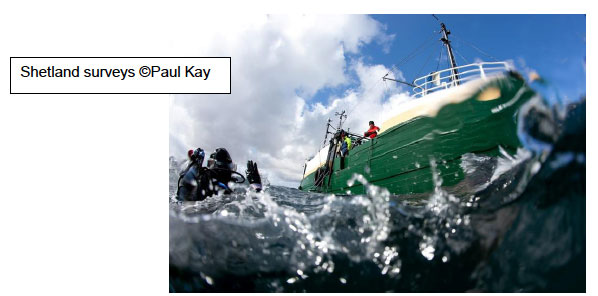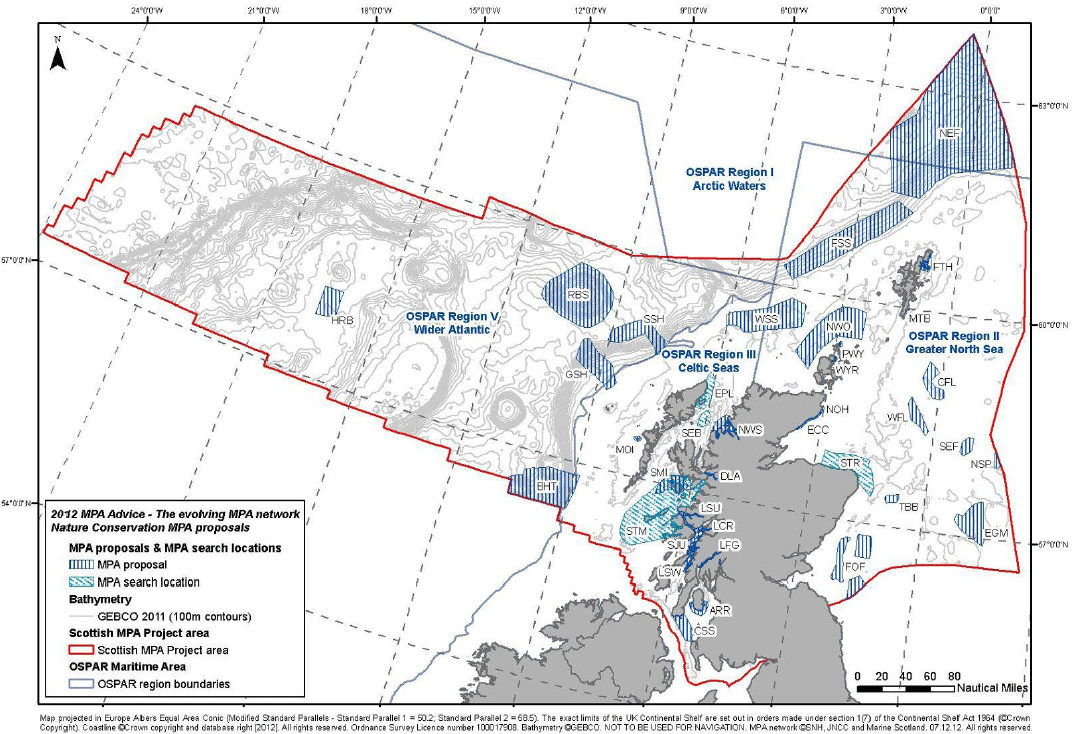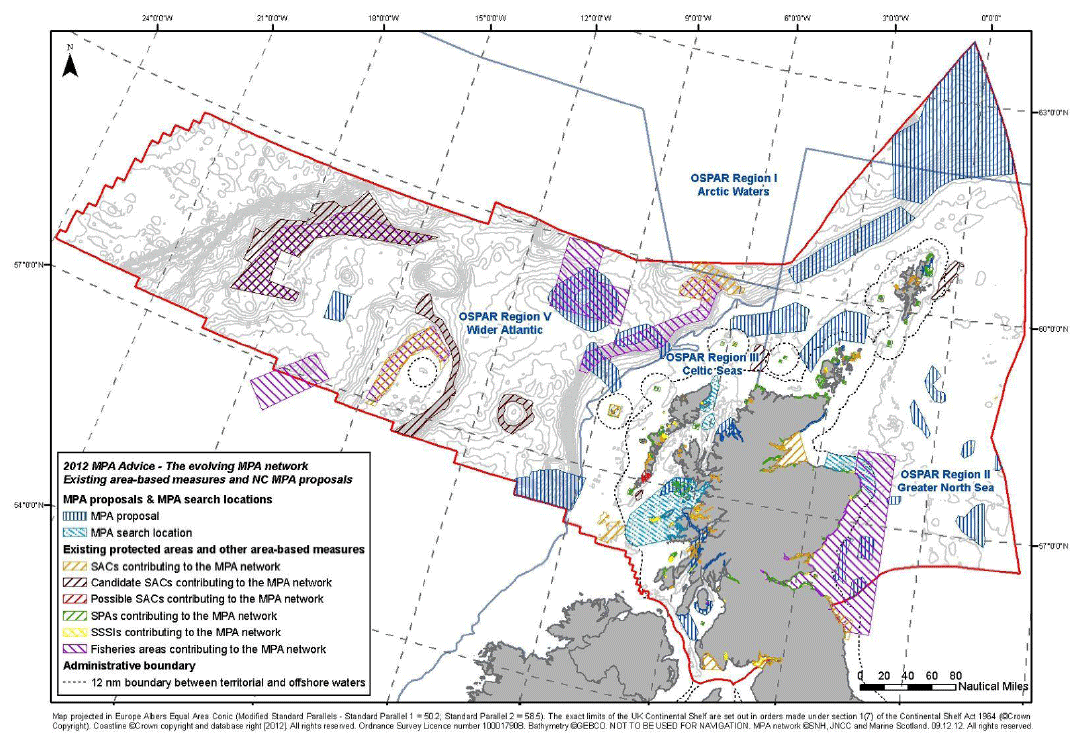Report to the Scottish Parliament on Progress to Identify a Scottish Network of Marine Protected Areas
This reports on which sites are currently included in the MPA network and outlines progress on Nature Conservation MPAs, Historic MPAs, and Demonstration and Research MPAs.
Background to the Development of the MPA Network
The protection of the our seas is a responsibility we are taking very seriously, and the climate of conservation in Scotland has changed for the best in the past few years.
Before 2007, there was no legal power to designate Marine Protected Areas of national importance in Scottish waters and the only powers available to designate MPAs to contribute to our international obligations were the powers available under the EU Birds and Habitats Directives, which only protect a limited number of marine habitats and species. The Marine (Scotland) Act in 2010 delivered new powers to protect other habitats and species of national and international importance.
Before 2007 protection of seabirds was restricted to seabird colonies on the coast or islands. In 2009 Scottish Ministers designated 31 sites to protect important marine habitats for seabirds and are also funding SNH and JNCC to identify other sites to meet our obligations under the EU Birds Directive.
Before 2007 there were no Special Areas of Conservation in Scottish offshore waters. Since 2008, 11 SACs have been designated in Scottish offshore waters, 9 of which protect important reef habitats. Hatton Bank is the largest marine protected area in the EU. We have also designated Scotland's only discovered coral reef in inshore waters as a Special Area of Conservation, East Mingulay.
Before 2007 there were no community MPAs. Scottish Ministers supported the Isle of Arran community's proposal for Scotland's first No Take Zone, created by law in Lamlash Bay in 2008.Scottish Ministers only had responsibility for nature conservation out to 12 nautical miles. Scottish Ministers now lead on nature conservation for offshore waters out to 200 nautical miles and beyond, and this includes powers to designate MPAs.
Nature Conservation
The Cabinet Secretary for Rural Affairs and Environment gave a Statement to Parliament on 1 st September 2010, following Royal Assent of the Marine (Scotland) Act, on his intention to develop a network of MPAs. A well managed MPA network would be identified, designated and managed to play a crucial role in the conservation of both biodiversity and geodiversity, offering long-term support for the services our seas provide to society, and also to protect for Scotland's outstanding marine cultural heritage.
The network is now being developed for the protection of the diversity of rare, threatened or representative species and habitats in Scotland's seas, which will form a significant part of the UK contribution to the wider North East Atlantic network.
The three pillars of Scottish Ministers' approach to marine nature conservation are site protection, species protection and wider seas policies and measures. MPAs are a key element of the site protection pillar.
Marine Scotland is working in partnership with Scottish Natural Heritage ( SNH), the Joint Nature Conservation Committee ( JNCC), Scottish Environment Protection Agency ( SEPA) and Historic Scotland ( HS).
This report is accompanied by the Scottish Natural Heritage and the Joint Nature Conservation Committee's (2012)Advice to the Scottish Government on the selection of Nature Conservation Marine Protected Areas ( MPAs) and the development of the Scottish MPA network, available on Scottish Natural Heritage [4] and Joint Nature Conservation Committee [5] websites . This provides the joint scientific advice from our Statutory Nature Conservation Bodies, SNH and JNCC, on existing protected areas and other area based measures that contribute to the network, as well as identification of Nature Conservation MPA proposals that could form part of a network to protect biodiversity and geodiversity. A significant part of the work behind the report has been based around ensuring that network and feature coverage satisfies the OSPAR (Oslo-Paris Convention for the Protection of the Marine Environment of the North-East Atlantic) principles of developing an ecologically coherent network, to then be able to say that within the network a feature has enough coverage.
A summary map (Figure 1) and table ( Table 1) follows of the Nature Conservation MPA proposals and search locations, as well as an overview of all proposed and existing marine conservation measures.
This Report to Parliament does not serve as a signal to consult on all proposals and search locations described in this and SNH and JNCC's advice. An announcement will be made in 2013 as to the proposed MPAs that will be presented at consultation.
Historic Scotland
Historic Scotland is taking forward the work on Historic MPAs as part of a range of actions to deliver its Strategy For Protection, Management And Promotion Of Marine Heritage 2012-15. This includes an objective of establishing a well-managed group of Historic MPAs in the seas around Scotland. To support this objective, Historic Scotland intend to take forward work to support three tranches of designation over the next three years.
Demonstration and Research MPAs
2 Demonstration & Research MPA proposals have been received, and are currently being assessed for inclusion in the network.

Table 1: Nature conservation MPA proposals and MPA search locations in Scottish waters (an asterisk denotes an area that is still at search location stage) Table 3 in Annex A provides detail on the features for protection.
| OSPAR Region(s) | MPA proposal/ MPA search location | Code | Territorial / Offshore |
|---|---|---|---|
| I, II & V | Faroe-Shetland sponge belt | FSS | Offshore |
| I & II | North-east Faroe Shetland Channel | NEF | Offshore |
| II | Central Fladen | CFL | Offshore |
| East Caithness Cliffs | ECC | Territorial | |
| East of Gannet and Montrose Fields | EGM | Offshore | |
| Fetlar to Haroldswick | FTH | Territorial | |
| Firth of Forth Banks Complex | FOF | Offshore | |
| Mousa to Boddam | MTB | Territorial | |
| North-west Orkney | NWO | Territorial | |
| Norwegian boundary sediment plain | NSP | Offshore | |
| Noss Head | NOH | Territorial | |
| Papa Westray | PWY | Territorial | |
| South-east Fladen | SEF | Offshore | |
| Southern Trench* | STR | Territorial | |
| Turbot Bank | TBB | Offshore | |
| Western Fladen | WFL | Offshore | |
| Wyre and Rousay Sounds | WYR | Territorial | |
| II & III | West Shetland Shelf (formerly Windsock) | WSS | Offshore |
| III | Clyde Sea Sill | CSS | Territorial |
| Eye Peninsula to Butt of Lewis* | EPL | Territorial | |
| Loch Creran | LCR | Territorial | |
| Lochs Duich, Long and Alsh | DLA | Territorial | |
| Loch Sunart | LSU | Territorial | |
| Loch Sunart to the Sound of Jura | SJU | Territorial | |
| Loch Sween | LSW | Territorial | |
| Monach Isles | MOI | Territorial | |
| North-west sea lochs and Summer Isles | NWS | Territorial | |
| Shiant East Bank* | SEB | Territorial | |
| Skye to Mull* | STM | Territorial | |
| Small Isles | SMI | Territorial | |
| South Arran | ARR | Territorial | |
| Upper Loch Fyne and Loch Goil | LFG | Territorial | |
| III & V | Geike Slide and Hebridean Slope | GSH | Offshore |
| South-west Sula Sgeir and Hebridean Slope | SSH | Offshore | |
| The Barra Fan and Hebrides Terrace Seamount | BHT | Offshore | |
| V | Hatton-Rockall Basin | HRB | Offshore |
| Rosemary Bank Seamount | RBS | Offshore |
Figure 1: Nature Conservation MPA proposals and search locations in Scotland's seas

Figure 2: Combined view of existing protected areas, other area-based measures, Nature Conservation MPA proposals and MPA search locations that could contribute to the Scottish MPA network

Contact
There is a problem
Thanks for your feedback